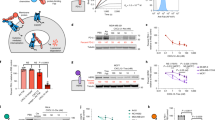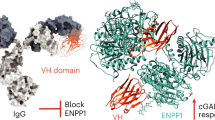Abstract
Addition of polyethylene glycol to protein (PEGylation) to improve stability and other characteristics is mostly nonspecific and may occur at all lysine residues, some of which may be within or near an active site. Resultant PEGylated proteins are heterogeneous and can show markedly lower bioactivity. We attempted to develop a strategy for site-specific mono-PEGylation using tumor necrosis factor-α (TNF-α). We prepared phage libraries expressing TNF-α mutants in which all the lysine residues were replaced with other amino acids. A fully bioactive lysine-deficient mutant TNF-α (mTNF-α-Lys(−)) was isolated by panning against TNF-α-neutralizing antibody despite reports that some lysine residues were essential for its bioactivity. mTNF-α-Lys(−) was site-specifically mono-PEGylated at its N terminus. This mono-PEGylated mTNF-α-Lys(−), with superior molecular uniformity, showed higher bioactivity in vitro and greater antitumor therapeutic potency than randomly mono-PEGylated wild-type TNF-α. These results suggest the usefulness of the phage display system for creating functional mutant proteins and of our site-specific PEGylation approach.
This is a preview of subscription content, access via your institution
Access options
Subscribe to this journal
Receive 12 print issues and online access
$209.00 per year
only $17.42 per issue
Buy this article
- Purchase on Springer Link
- Instant access to full article PDF
Prices may be subject to local taxes which are calculated during checkout





Similar content being viewed by others
References
Skillings, J. et al. A phase II study of recombinant tumor necrosis factor in renal cell carcinoma: a study of the National Cancer Institute of Canada Clinical Trials Group. J. Immunother. 11, 67–70 (1992).
Price, T.H. et al. Phase I/II trial of neutrophil transfusions from donors stimulated with G-CSF and dexamethasone for treatment of patients with infections in hematopoietic stem cell transplantation. Blood 95, 3302–3309 (2000).
Schmidinger, M. et al. Sequential administration of interferon-γ, GM-CSF, and interleukin-2 in patients with metastatic renal cell carcinoma: results of a phase II trial. J. Immunother. 24, 257–262 (2001).
Kimura, K. et al. Phase I study of recombinant human tumor necrosis factor. Cancer Chemother. Pharmacol. 20, 223–229 (1987).
Bory, C. et al. Effect of polyethylene glycol-modified adenosine deaminase (PEG-ADA) therapy in two ADA-deficient children: measurement of erythrocyte deoxyadenosine triphosphate as a useful tool. Adv. Exp. Med. Biol. 309A, 173–176 (1991).
Keating, M.J. et al. Lasparaginase and PEG asparaginase—past, present, and future. Leuk. Lymphoma 10 (Suppl.), 153–157 (1993).
Jen, J.F. et al. Population pharmacokinetic analysis of pegylated interferon α2b and interferon α2b in patients with chronic hepatitis C. Clin. Pharmacol. Ther. 69, 407–421 (2001).
Poynard, T. et al. Impact of pegylated interferon α2b and ribavirin on liver fibrosis in patients with chronic hepatitis C. Gastroenterology 122, 1303–1313 (2002).
Tsutsumi, Y. et al. Molecular design of hybrid tumour necrosis factor-α with polyethylene glycol increases its anti-tumour potency. Br. J. Cancer 71, 963–968 (1995).
Kaneda, Y. et al. Antitumor activity of tumor necrosis factor-α conjugated with divinyl ether and maleic anhydride copolymer on solid tumors in mice. Cancer Res. 58, 290–295 (1998).
Kamada, H. et al. Antitumor activity of tumor necrosis factor-α conjugated with polyvinylpyrrolidone on solid tumors in mice. Cancer Res. 60, 6416–6420 (2000).
Tsutsumi, Y. et al. PEGylation of interleukin-6 effectively increases its thrombopoietic potency. Thromb. Haemost. 77, 168–173 (1997).
Tsunoda, S. et al. Molecular design of polyvinylpyrrolidone-conjugated interleukin-6 for enhancement of in vivo thrombopoietic activity in mice. J. Control. Release 68, 335–341 (2000).
Tsutsumi, Y. et al. Site-specific chemical modification with polyethylene glycol of recombinant immunotoxin anti-Tac(Fv)-PE38 (LMB-2) improves antitumor activity and reduces animal toxicity and immunogenicity. Proc. Natl. Acad. Sci. USA 97, 8548–8553 (2000).
Monkarsh, S.P. et al. Positional isomers of monopegylated interferon α2a: isolation, characterization, and biological activity. Anal. Biochem. 247, 434–440 (1997).
Bailon, P. et al. Rational design of a potent, long-lasting form of interferon: a 40 kDa branched polyethylene glycol-conjugated interferon α2a for the treatment of hepatitis C. Bioconjug. Chem. 12, 195–202 (2001).
Grace, M. et al. Structural and biologic characterization of pegylated recombinant IFN-α2b. J. Interferon Cytokine Res. 21, 1103–1115 (2001).
He, X.H. et al. Site-directed polyethylene glycol modification of trichosanthin: effects on its biological activities, pharmacokinetics, and antigenicity. Life Sci. 64, 1163–1175 (1999).
Kuan, C.T. et al. Pseudomonas exotoxin A mutants. Replacement of surface-exposed residues in domain II with cysteine residues that can be modified with polyethylene glycol in a site-specific manner. J. Biol. Chem. 269, 7610–7616 (1994).
Carswell, E.A. et al. An endotoxin-induced serum factor that causes necrosis of tumors. Proc. Natl. Acad. Sci. USA 72, 3666–3670 (1975).
Skillings, J. et al. A phase II study of recombinant tumor necrosis factor in renal cell carcinoma: a study of the National Cancer Institute of Canada Clinical Trials Group. J. Immunother. 1, 67–70 (1992).
Sella, A. et al. Phase I study of tumor necrosis factor plus actinomycin D in patients with androgen-independent prostate cancer. Cancer Biother. 10, 225–235 (1995).
Jones, E.Y., Stuart, D.I. & Walker, N.P. Structure of tumour necrosis factor. Nature 338, 225–228 (1989).
Yamagishi, J. et al. Mutational analysis of structure–activity relationships in human tumor necrosis factor-α. Protein Eng. 3, 713–719 (1990).
Van Ostade, X. et al. Localization of the active site of human tumour necrosis factor (hTNF) by mutational analysis. EMBO J. 10, 827–836 (1991).
Smith, G.P. Filamentous fusion phage: novel expression vectors that display cloned antigens on the virion surface. Science 228, 1315–1317 (1985).
Parmley, S.F. et al. Antibody-selectable filamentous fd phage vectors: affinity purification of target genes. Gene 73, 305–318 (1988).
Pasqualini, R. et al. Organ targeting in vivo using phage display peptide libraries. Nature 380, 364–366 (1996).
Tsutsumi, Y. et al. Molecular design of hybrid tumor necrosis factor-α III: polyethylene glycol-modified tumor necrosis factor-α has markedly enhanced antitumor potency due to longer plasma half-life and higher tumor accumulation. J. Pharmacol. Exp. Ther. 278, 1006–1011 (1996).
Okada, N. et al. Elective enhancement by tumor necrosis factor-α of vascular permeability of new blood vessels induced with agarose hydrogel-entrapped Meth-A fibrosarcoma cells. Jpn. J. Cancer Res. 87, 831–836 (1996).
Chowdhury, S.P. et al. Improving antibody affinity by mimicking somatic hypermutation in vitro. Nat. Biotechnol. 17, 568–572 (1999).
Kurfurst, M.M. Detection and molecular weight determination of polyethylene glycol-modified hirudin by staining after sodium dodecyl sulfate-polyacrylamide gel electrophoresis. Anal. Biochem. 200, 244–248 (1992).
National Institutes of Health. Principles of Laboratory Animal Care. NIH Publication 85-23, rev. (National Institutes of Health, Baltimore, MD, 1985)
Haranaka, K. et al. Antitumor activity of murine tumor necrosis factor (TNF) against transplanted murine tumors and heterotransplanted human tumors in nude mice. Int. J. Cancer 34, 263–267 (1984).
Acknowledgements
This study was supported in part by a Grant-in-Aid for Scientific Research (No. 13672385) from the Ministry of Education, Science and Culture of Japan, and in part by Health Sciences Research Grants for Research on Health Sciences focusing on Drug Innovation from the Japan Health Sciences Foundation (KH63124). We thank Ira Pastan (US National Cancer Institute, National Institutes of Health) for advice and discussion, and Kenneth Santora (a member of Ira Pastan's lab at NCI/NIH) for editorial assistance.
Author information
Authors and Affiliations
Corresponding author
Ethics declarations
Competing interests
The authors declare no competing financial interests.
Rights and permissions
About this article
Cite this article
Yamamoto, Y., Tsutsumi, Y., Yoshioka, Y. et al. Site-specific PEGylation of a lysine-deficient TNF-α with full bioactivity. Nat Biotechnol 21, 546–552 (2003). https://doi.org/10.1038/nbt812
Received:
Accepted:
Published:
Issue Date:
DOI: https://doi.org/10.1038/nbt812
This article is cited by
-
PEGylation of a High-Affinity Anti-(+)Methamphetamine Single Chain Antibody Fragment Extends Functional Half-Life by Reducing Clearance
Pharmaceutical Research (2016)
-
PRINT: A Protein Bioconjugation Method with Exquisite N-terminal Specificity
Scientific Reports (2015)
-
Experimental Evolution of a Green Fluorescent Protein Composed of 19 Unique Amino Acids without Tryptophan
Origins of Life and Evolution of Biospheres (2014)
-
Pegylated TRAIL retains anti-leukemic cytotoxicity and exhibits improved signal transduction activity with respect to TRAIL
Investigational New Drugs (2012)
-
Site-Specific PEGylation of Therapeutic Proteins via Optimization of Both Accessible Reactive Amino Acid Residues and PEG Derivatives
BioDrugs (2012)



